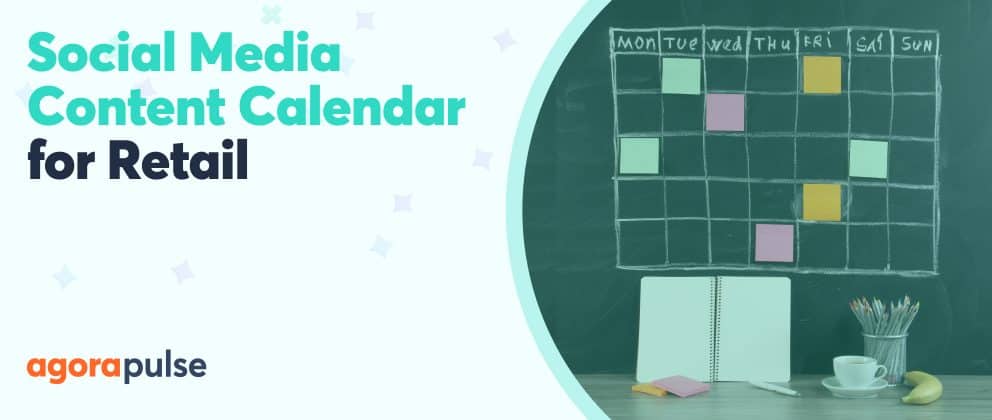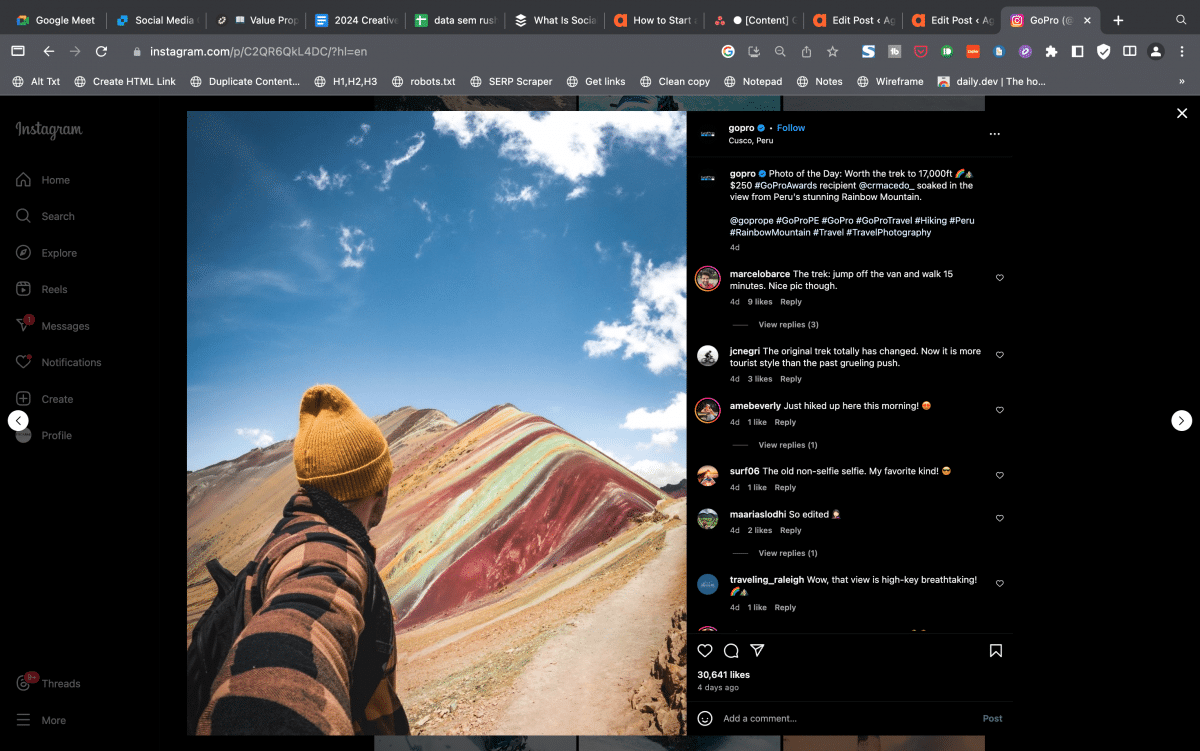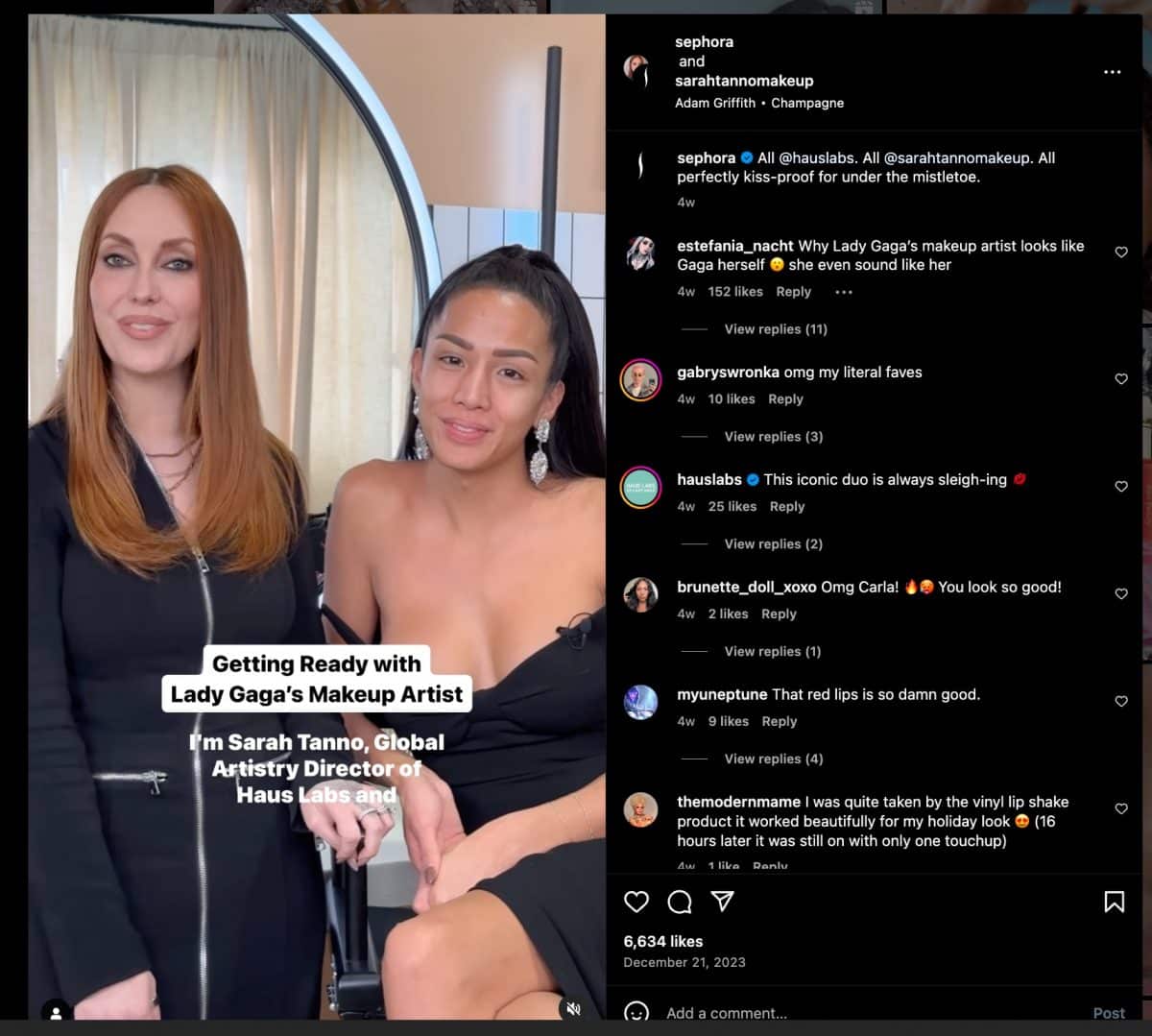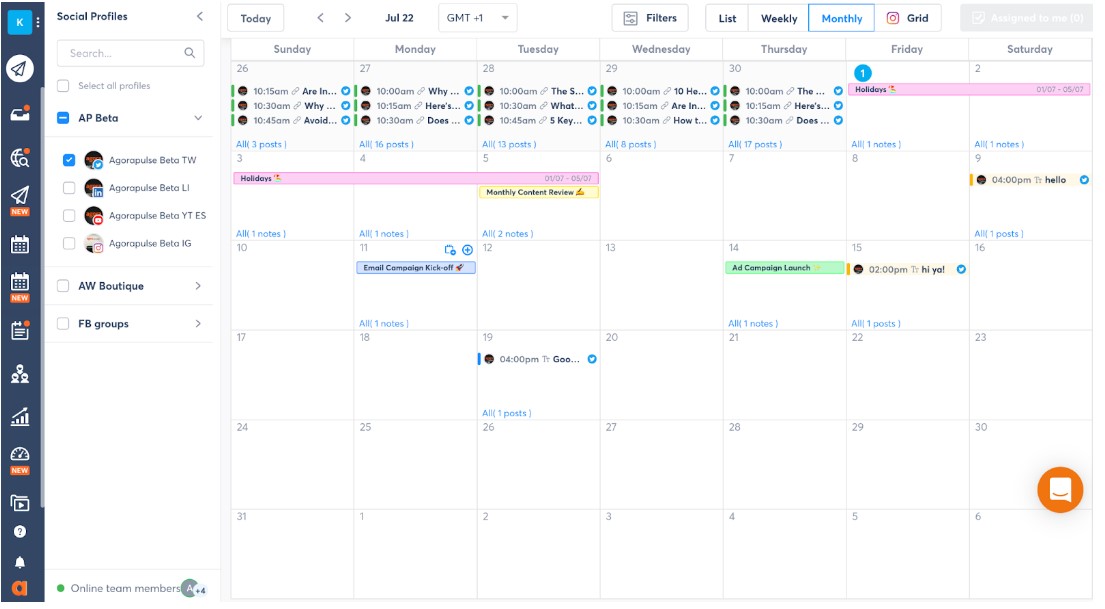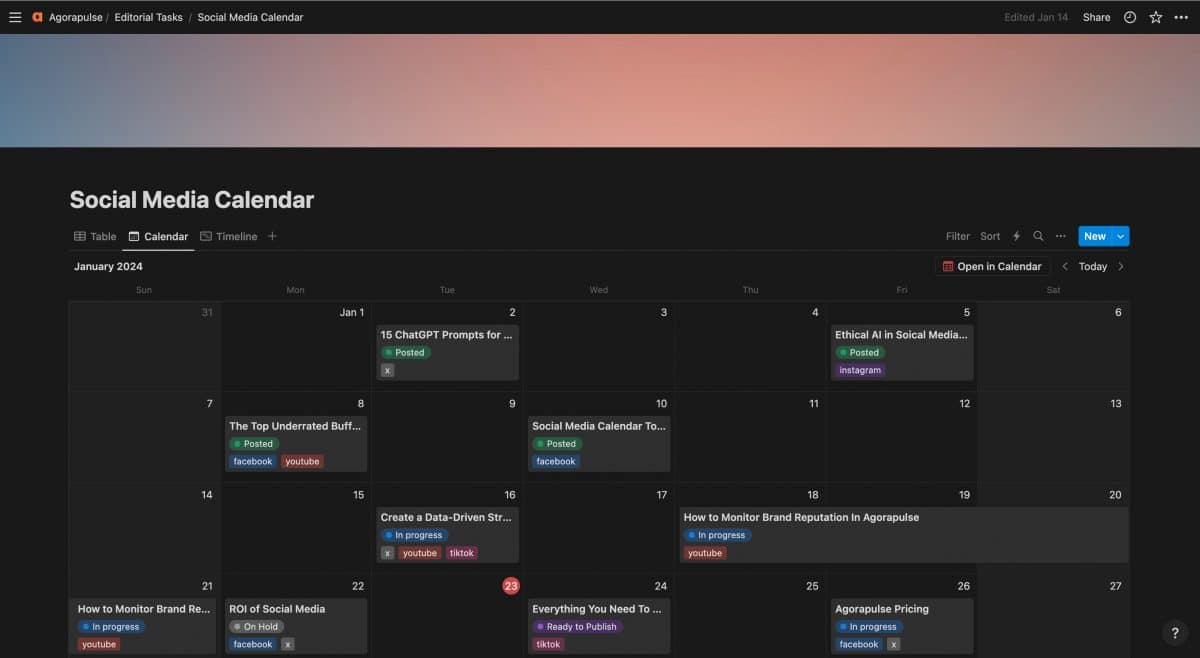The retail world moves faster than a high-speed train, with new trends, busy shopping seasons, and constantly changing customer preferences. The social media world moves even faster. But with a social media content calendar for retail, you can make sure your social media content is always on point.
In the following sections, we’re going to break down how to create a killer social media content calendar for retail. Or you can sign up now for a free trial of our social media management tool and start planning right away.
What Is a Social Media Content Calendar?
A social media content calendar is a schedule of when and what you’re going to post on your various social media platforms.
It’s the game plan, the strategy, the “let’s not lose our minds today” blueprint for keeping your social media more organized than professional organizer Marie Kondo’s sock drawer.
Benefits of Using a Social Media Content Calendar for Retail
So why should you use a social media content calendar for retail? Well, if you value your sanity, it’s probably a good idea. But if that’s not a good enough reason for you, here’s a few more benefits of using a social media calendar.
Boost in-store traffic
For retailers with physical stores, a content calendar can help drive in-store traffic by planning content around in-store events, promotions, or exclusive in-store offers.
In fact, retailers using social media effectively have seen up to a 35% increase in foot traffic to physical stores.
Unified brand voice
Consistent, well-planned content contributes to long-term brand recognition and loyalty and increase revenue by up to 23%, according to study done by Lucidpress.
Brand recognition is particularly important for grocery and apparel retailers, as they often have frequent repeat customers. A content calendar can help you maintain that consistent brand identity and messaging across different geographies, ensuring your customers receive the same brand experience whether they’re at a store in Nevada or New York.
Seasonal campaign precision
A study by the National Retail Federation highlighted that holiday sales represent about 25% of annual retail sales. A content calendar ensures you are able to make the most of this high-volume shopping season with well-planned and timely campaigns.
Long-term thinking and strategy
Moreover, a study by Bain & Company found that companies with long-term growth strategies outperform their peers in revenue and profits. So, a social media content calendar for retail can help in visualizing the long-term strategy. Then, your social media efforts contribute to overarching business goals. This approach will help you plan posts that are more strategic instead of just jumping on the latest TikTok trend.
Risk mitigation
Ever had two stores run different sales at the same time? It’s a nightmare. A social media content calendar provides a clear overview of what is being posted and when. Using one also can help prevent costly mix ups, such as different promotions on social from store to store or poorly timed posts
Influencer and partnership integration
For collaborations with influencers or other brands, a content calendar ensures these partnerships are strategically placed for maximum impact.
Stay compliant
Especially relevant for large companies, planning content in advance allows for proper review processes to ensure compliance with advertising standards and regulations.
Team harmony
Alignment across your teams helps your company perform better.
Using a social media content calendar facilitates that alignment by clearly defining roles and responsibilities, ensuring all departments work towards common goals. This organization of your teams is also crucial for running a smooth operation and preventing any last-minute chaos.
Sign up now for a FREE trial of Agorapulse!
Understanding Your Target Audience
Before we get into building your calendar, let me ask you one question: Do you know who your target audience is? I mean, really know them. Because if you want the content in your social media calendar to be effective, you need to know your audience better than the back of your hand.
So if you don’t have solid buyer personas created yet, now is a good time to make them! (And if you do have them made, its always a good practice to review them to ensure they are still accurate and as detailed as they could be.)
And if you feel lost and don’t know what buyer personas are, this next section is for you.
What are buyer personas?
Buyer personas are fictional representations of your ideal customers based on market research and real data about your existing customers. They go beyond basic demographic information to include deeper insights like:
- Customer motivations
- Behavior patterns
- Goals
- Pain points
Your buyer personas will ultimately guide you to make better business decisions on things like your marketing strategy, store layout, or even location or hours of the business. They can help you tailor the shopping experience, both online and offline, to meet the unique needs of each persona. That way, you can be sure that your decisions are aligned with the preferences and expectations of your buyers, which will lead to satisfied and loyal customers that keep coming back!
How to Create Buyer Personas for Retail Brands
Gather data
Start by collecting data from your existing customers. This can include:
- Demographic information
- Purchasing behavior
- Feedback
- Loyalty program data
Surveys, interviews, and social media analytics are also valuable sources of information.
Do some digging into what types of content and topics they are interested in. This can be done by looking at the content of your competitors, analyzing retail trends for your niche, or you can even simply ask your current customers what they are interested in by conducting 1:1 interviews. (Check out Agorapulse’s Social Trends tool to dig deeper into the trends happening on social media.)
Other tools out there can give you deeper insights about your audience, such as SparkToro or Agorapulse’s Social Monitoring feature. With Agorapulse, you can track important keywords associated with your brand or niche, and see what people are saying about them. There are a ton of cool things to do with the social listening in Agorapulse. Watch the video below to see how Agorapulse can help you understand your audience on social on a new level.
Identify trends and patterns
Look for common characteristics and patterns in your data. This could be related to shopping habits, product preferences, lifestyle choices, and other relevant factors.
Then you want to segment your audience into different groups based on the trends you have identified. Each group represents a potential buyer persona.
Detail each persona
For each persona, create a detailed profile. This should include:
- Demographic information: Age, gender, location, income level, etc.
- Psychographics: Interests, values, attitudes, and lifestyle
- Shopping behavior: Buying motivation, preferred shopping channels, frequency of purchases, average spend, product preferences
- Goals and challenges: What are they trying to achieve when shopping with your brand? What obstacles do they face in the process?
- Name and visualize the personas: Give each persona a name and a face. This helps in visualizing them as real customers and makes it easier for your team to understand and remember them.
Apply the personas
Use these personas to guide your marketing strategies, product selections, store layout, and customer service approach. For instance, if one of your personas is a tech-savvy millennial, you might focus on enhancing your e-commerce platform and using social media for marketing.
Once you have done your research, you should have a basic idea of what types of content your audience engages with. This is going to be super helpful you when it comes to the next step: deciding your content pillars.
Choosing Your Content Pillars
These pillars serve as guiding themes to help ensure your content remains consistent with your brand identity. Also, content pillars will make coming up with ideas for posts a heck of a lot easier.
You will want to choose 3-6 content pillars for your brand. Some of the more commonly used pillars for retail include:
Product showcases: This includes posts about a specific product, often these posts will highlight new arrivals, bestsellers, or limited-edition products.
Here’s an example of how Lowe’s does this really well on Facebook by creating an engaging post that demonstrates the unique features of the washer and dryer with a video.
Success stories: We all love a good “win.” Maybe it’s a post about a product that sold out super fast, or a sharing great customer testimonial. These real-life moments aren’t just relatable, they’re also social proof that you’re doing something right.
GoPro is a brand that does this really well by showcasing user-generated content on their Instagram page.
Behind the scenes: This content pillar is exactly as it sounds: a behind-the-scenes look into your business operations, values, or culture. Posts might include things like employee spotlights, videos, or photos of how your product is made. Your behind-the-scenes content could even be a co-branding partnership play like this Instagram post by Sephora and Sarah Tanno Makeup.
Educational content: This pillar is dedicated to providing valuable information related to your niche. These posts can be things like how-to guides, product usage tips, or industry news.
Lifestyle/inspirational: This content is anything that aligns your brand with a certain lifestyle or identity, such as posts depicting the lifestyle of your target audience, and motivational or inspirational content.
Promotions/sales: Pretty straightforward, this pillar is for announcing special offers, sales, or exclusive deals.
These don’t have to be the pillars you use (and it is probably better if you create your own) but they can be a good starting point if you are unsure where to start. Remember to review your content pillars every few months to see if they are still working, and if not, experiment and try something else!
Sign up now for a FREE trial of Agorapulse!
Tools to Create Your Retail Social Media Calendar
Now that you know your audience and have your content pillars, you’re almost all set to start planning your own social media content calendar for retail. But there’s one thing left to decide first: What tools will you use for creating your calendar?
Now, for most retail businesses, you are probably going to want something a bit more sophisticated than just a pen and paper (although if that’s what works for you then go for it!). But there are dozens of tools out there to help you create and plan your content calendar (far too many for me to include them all in this post)! But, I am going to quickly share a couple of suggestions you might want to consider.
Agorapulse
While I may be a bit biased here, this list wouldn’t be complete without Agorapulse. And that’s because scheduling and planning social media content is one of the things that Agorapulse does best. With an easy drag-and-drop calendar, you can quickly plan, draft, schedule, and publish your social media content all in the same place.
You can even leave notes, assign posts to your team, and share your planned content calendar with clients or external stakeholders to get their approval. Plus, you get access to detailed analytics and reporting, which makes it easier for you to see what posts are working and which ones aren’t.
Get your free 30 day trial of Agorapulse!
Asana
Another option to consider for creating your social media content calendar is to use a project management app like Asana. While Asana may not be able to provide you with post analytics or help you actually schedule and publish your social media posts, it can still be useful to manage any tasks associated with creating your post content.
If you have a large team that includes writers, graphic designers, and social media managers, you likely need a platform like this to help keep everything on track. There is also a calendar view that can be used to get a birds-eye look at everything you’ve got planned for the month.
Notion
Notion is another one of my favorites for creating a social media content calendar. The reason that I like Notion is because it is super flexible and easy to customize it to your exact needs.
However, because of this, you will need to dedicate some time at the beginning to set things up how you want it—meaning it may not be that quick of a solution right out of the gate. But if you have the time to do so, it can be a good option.
Note that like Asana, Notion doesn’t offer you any social media publishing features, so you still would need to manually copy your drafted posts from Notion into each social media platform when you’re ready to post it.
Excel/Google Sheets
If you’re more of a spreadsheet kind of person, then using Excel or Google Sheets may be the way to go. Don’t get me wrong, I do love a good spreadsheet, but in my personal experience this isn’t really an ideal way to plan your calendar. I’ve included it here because it is a popular choice still that many people swear by. It’s also completely free and can be used offline, which can’t be said about the previous tools. But realistically, how much time do you spend in places with no Internet anyways? (Not much, I am guessing.)
Most importantly, you want to find a tool that is going to work well for you and your team. Once you’ve found the right solution, you can get down to actually creating your calendar.
Usually, a social media content calendar will include the following information:
- Date to post: Dates and times for when each post will go live
- Type of content: Information about what each post will contain (e.g., text, images, links)
- Creator(s): Who is responsible for creating the content. This may be several people if your team includes graphic designers, writers, and video content creators or influencers.
- Platforms: Where the post will be published (Instagram, Facebook, LinkedIn etc.)
- Status tracking: Notes on the post’s current status (planned, drafted, scheduled, published)
- Performance metrics: Data to track how well each post performs once published (optional).
For retailers, it may be useful to note a couple of other things such as the sale, product, or store location associated with the post. Additionally, if your company has separate social accounts for each store or geographic region, you may want to note down the language of the post, or include if the post is to be translated for other regions.
Tips for Building an Effective Retail Social Media Content Calendar
Here’s some tips for creating an effective retail social media content calendar:
Mark down important dates
First things first, start marking those big retail moments. Think about holidays, seasonal changes, and major sales events that align with your brand. These dates are your anchor points for content. You can even make note of fun or quirky dates that are aligned with your brand. For example, outdoors clothing retailers could make note of National Take a Hike Day. Or for beauty brands can observe National Lipstick Day.
Keep social media content balanced
Your content should be a balanced mix of different types of content, and you want to also rotate between each of your content pillars. Remember that your audience doesn’t just want to see posts about your brand, so we suggest following the 80/20 Rule. This rule suggests that you use 20% of your content to promote your brand, and the other 80% should focus on content that genuinely interests and engages your audience in meaningful conversations.
Leave room for user-generated content (UGC)
Nothing speaks louder than your real customers loving your products. UGC is authentic, relatable, and one of the best ways to connect with your audience. Encourage them to share their experiences and photos, and then you can feature these in your calendar.
Plan, but stay flexible
While it’s great to have a plan, social media moves fast. Stay open to tweaking your calendar. Maybe there’s a sudden TikTok trend you want to jump on, or you need to shift gears based on feedback from your audience. Flexibility is your friend here.
In Conclusion
Bottom line, creating a social media content calendar for your retail business isn’t something you can avoid doing. It’s become an integral part of creating an effective social media marketing strategy that will help you grow your audience (and your retail business). Grab a free trial of Agorapulse and see how easy it is to plan and stay on top of your retail social media calendar.
